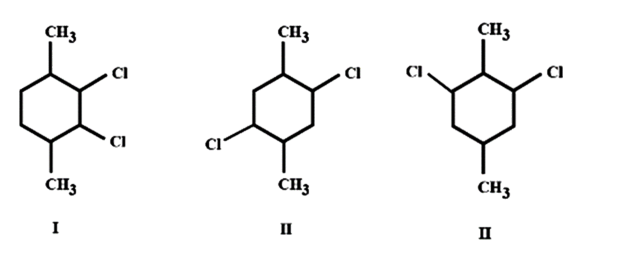Explain the following:
lonic compounds have high melting point and boiling point while covalent compounds have low melting and boiling points.
Step-by-Step Text Solution:
1. Definition of Ionic Compounds: Ionic compounds are formed through ionic bonding, which involves the transfer of electrons from one atom to another.
2. Example of Ionic Bonding: Consider sodium chloride (NaCl). Sodium (Na) has one electron in its outermost shell, while chlorine (Cl) has seven electrons. Sodium transfers its one electron to chlorine, resulting in the formation of Na⁺ (sodium ion) and Cl⁻ (chloride ion). These oppositely charged ions attract each other, forming a strong ionic bond.
3. Properties of Ionic Compounds: Due to the strong electrostatic forces of attraction between the positively and negatively charged ions, ionic compounds have high melting and boiling points. A significant amount of energy is required to overcome these strong attractions to break the ionic bonds.
4. Definition of Covalent Compounds: Covalent compounds are formed through covalent bonding, which involves the sharing of electrons between atoms.
5. Example of Covalent Bonding: Take methane (CH₄) as an example. In methane, carbon shares its four valence electrons with four hydrogen atoms. Each hydrogen atom shares one electron with carbon, resulting in a stable molecule without the transfer of electrons.
6. Properties of Covalent Compounds: The forces of attraction between covalent molecules are generally weaker than those in ionic compounds. As a result, covalent compounds typically have lower melting and boiling points because less energy is required to overcome these weaker intermolecular forces.
7. Conclusion: In summary, ionic compounds have high melting and boiling points due to the strong electrostatic forces between ions, while covalent compounds have low melting and boiling points because of the weaker forces resulting from shared electrons.
Topper's Solved these Questions
- CHEMICAL BONDING BOOK - ICSECHAPTER - CHEMICAL BONDING EXERCISE - Questions from Previous ICSE Board Papers (2005)
7 Videos
- CHEMICAL BONDING BOOK - ICSECHAPTER - CHEMICAL BONDING EXERCISE - Questions from Previous ICSE Board Papers (2006)
5 Videos
- CHEMICAL BONDING BOOK - ICSECHAPTER - CHEMICAL BONDING EXERCISE - WORKSHEET-3(Tick the correct answer)
5 Videos
- ANALYTICAL CHEMISTRY-USE OF AMMONIUM & SODIUM HYDROXIDEBOOK - ICSECHAPTER - ANALYTICAL CHEMISTRY-USE OF AMMONIUM & SODIUM HYDROXIDEEXERCISE - Additional Questions
6 Videos
- CHEMISTRY 2011BOOK - ICSECHAPTER - CHEMISTRY 2011EXERCISE - SECTION-II
48 Videos
Similar Questions
Knowledge Check
Which of the following compounds will have highest melting point?
AChlorobenzeneBo-DichlorobenzeneCm-DichlorobenzeneDp-Dichlorobenzene
Covalent compounds possess very high melting and boiling points.
View SolutionWhy do ionic compounds possess high melting and boiling points ?
View SolutionOrganic compounds have .........melting and boiling points.
View SolutionWhich of the following compounds will have highest melting point ?

View SolutionCompounds having lowest melting point:
View SolutionExplain why
ionic compounds possess very high melting and boiling points?
View SolutionCovalent compounds have low melting points because
View Solution
